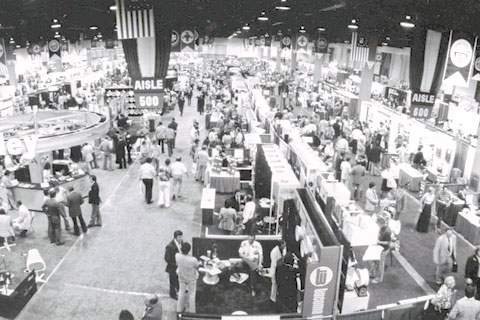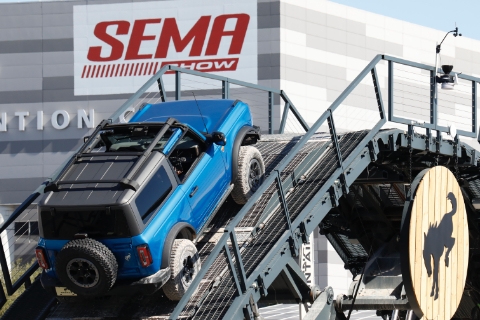SEMA News—June 2013
Q&A With Doug Evans
 SEMA News: Why are you running for the chair-elect position on the SEMA Board of Directors?
SEMA News: Why are you running for the chair-elect position on the SEMA Board of Directors?
Doug Evans: I am honored to be running! I feel we are at a critical juncture with our industry, and my three decades of experience can help ensure a bright future for SEMA and future generations of enthusiasts. I have been involved directly with SEMA for close to 20 years, serving on committees, the Board and as chairman of our PAC and the SEMA Show committee. I feel this experience makes me the clear choice to lead us through the transformation to the digital age while also honoring our past. I am no stranger to running a large, multifaceted operation, and that skill set translates perfectly to leading the SEMA team and board on a day-to-day basis.
SN: For small businesses, the past five years have been focused on coping with the recession. Now that the economy is slowly beginning to improve, what do you think is the biggest challenge facing small businesses? What should the association be doing to help?
DE: I think the single largest issue facing the industry is the Affordable Care Act, or Obamacare. At a time when businesses are cautiously considering buying new equipment and adding employees, they are faced with determining how to best deal with the rollout of the new healthcare laws and what the cost will be.
Doug Evans I have had the pleasure of working in our industry for more than 30 years. I have worked directly with companies ranging from small manufacturers and WDs to Fortune 500s on everything from product design and testing to supply chain recommendations, as well as national and local retail promotions with consumers. This diverse experience is the right fit for the issues facing our association today. Our marketplace is undergoing unprecedented change impacted by business technology, the Internet, supply chain evolution, globalization, an aging enthusiast demographic and governmental intrusions, to name a few. As your SEMA Chairman, I will take decisive action to help members understand these forces of change and arm you with information to make better business decisions to maintain and grow your companies. I will make the following my priorities: Legislative/Regulatory–I will monitor and quickly act upon legislative and regulatory developments and work to keep government out of our wallets and out of our sports. Stimulating the Business Environment–I will propose a series of educational and community outreach initiatives to stimulate youth involvement and brick-and-mortar parts sales nationwide. I will focus on business technology, helping our members to understand and utilize these emerging technologies to grow our segment and make us more profitable. I will place greater emphasis and resources toward helping member companies achieve their goals through ongoing development of relationships with OEMs and technical colleges, and access to SEMA’s new Diamond Bar tech center and studio. SEMA Finances–I will remain vigilant about managing SEMA’s resources and continue to look for ways to keep all membership costs in check, while also diversifying revenue streams for the association. 30-Plus Years of Industry and SEMA Experience: SEMA: | |
SEMA is one of the largest collections of small businesses in the world, and no group will have greater difficulty navigating these new laws and feeling their impact than small businesses. SEMA needs to provide easy-to-understand information and resources to members in order to help them make the best decisions possible with the new laws. SEMA also needs to revive our efforts from several years ago that allowed associations to come together across state lines to buy insurance in a pool. As chairman of the SEMA PAC, I led the charge with the help of SEMA’s terrific staff in Washington, D.C., and we came very close to getting this bill to pass the Senate. Now is the time to bring it up again and get it passed. This would potentially collectively save members millions of dollars on insurance. We were so close! This time we simply must win the fight!
SN: Recruiting young people to work in the specialty-equipment industry continues to be an important initiative at SEMA. As chairman, what do you hope to accomplish on this issue beyond supporting SEMA’s existing programs?
DE: I think this is one of the most significant and difficult issues our industry faces. Aging demographics of enthusiasts buying our products and working in the industry must be addressed immediately! I have a program that I have been working on called SEMA’s Shop Class in a Box.
The concept is to acquire federal grant money to put auto-shop classes back in high schools with additional backing, with both money and time, from volunteers within the industry. SEMA can help create a pathway for future leaders in our industry by starting this program and guiding our children to careers in the industry early on. It is a fact that there are far too many people going to college that have little hope of getting a job that justifies the expense of the college. It is also a fact that we are experiencing a shortage of skilled tradesmen and tradeswomen. Why not guide young enthusiasts to an industry that is not only fun and enjoyable but also where they can make great money? This enthusiasm also creates buyers for our products in perpetuity.
SN: The SEMA Data Co-op is beginning to gain critical mass in terms of industry participation, with nearly 200 suppliers and 142 receivers participating. Yet there remains an opportunity to build further infrastructure to accommodate the needs of different segments as well as new tools to make the process easier. Where do you see the SEMA Data Co-op in five years, and what kind of priority would you assign to move the project closer to achieving its goal of opening sales to new customers?
DE: I have had the pleasure of being involved in discussions about the Data Co-op since the early stages, while serving on the Board of Directors. Since my term ended, it has been extremely gratifying to see all the years of hard work put into this project finally coming to fruition. I would definitely assign a very high priority to seeing this project through and ensuring it is given room to adapt and thrive.
I see the Data Co-op as an ever-changing project and process. It is vital that the industry has a common repository of data and make sure we all speak the same data language. Without it, companies spend thousands of wasted hours and dollars re-creating data sets over and over again. It also makes it more difficult for consumers to find what they are looking to buy. Five years from now, I expect that the industry will wonder how it ever got along without the Data Co-op. But it is constantly changing and evolving, similar to our own efforts at Source Interlink in the digital world, so the Data Co-op is likely to be very different in five years than what we see today. The Data Co-op needs to be looking into the future and changing to meet where we are headed, not where we have been. I have no doubt the staff leadership will do just that, and as chairman, I will ensure it.
SN: Designing parts that synchronize and complement the latest breakthroughs in automotive technology requires a substantial research-and-development investment. During your tenure as chairman, what advancements would you like to see in the benefits and services SEMA offers to member companies in the manufacturing sector to enable them to cope with changes now on the horizon?
DE: SEMA has done a terrific job with our Tech Transfer program, with Ford, GM, Chrysler and other OEMs participating in sharing computer-aided design drawings and measurements in advance of new platform launches. This allows companies immediate access to this data without having to wait for the actual vehicle and reverse engineer it.
In addition to this, SEMA has state-of-the-art prototyping capabilities in Diamond Bar, complete with a 3D printer. This is open to all SEMA manufacturers and can save millions of dollars for companies that choose to use it. In addition, the new tech center that is being built—complete with a photo cove—is very exciting. The tech center will allow companies to utilize smog sensors, dynos and everything in between to prepare for actual certification from the ARB. This is a huge win for SEMA manufacturers. As chairman, I would build on both of these tools and consider building additional facilities in the Midwest and East Coast if the demand is there.
SN: In both the Middle East and China, SEMA now hosts successful events designed to introduce our members to these markets with meetings between manufacturers and buyers, and more of these kinds of events are in the planning stages. How should we decide about which new markets to prioritize as SEMA-member companies increase their ability to sell globally?
DE: Timing on this issue is critical because this is an enormous untapped marketplace for SEMA companies as more and more OEMs create global platforms. Utilizing SEMA’s robust research capabilities, I would survey member companies, including media companies, to determine where parts are being sold and how enthusiasts from emerging markets are getting information on our products. SEMA can then begin to create benchmarks of critical mass to determine where to put our resources to capture these new enthusiasts and get them access to products from SEMA companies.








